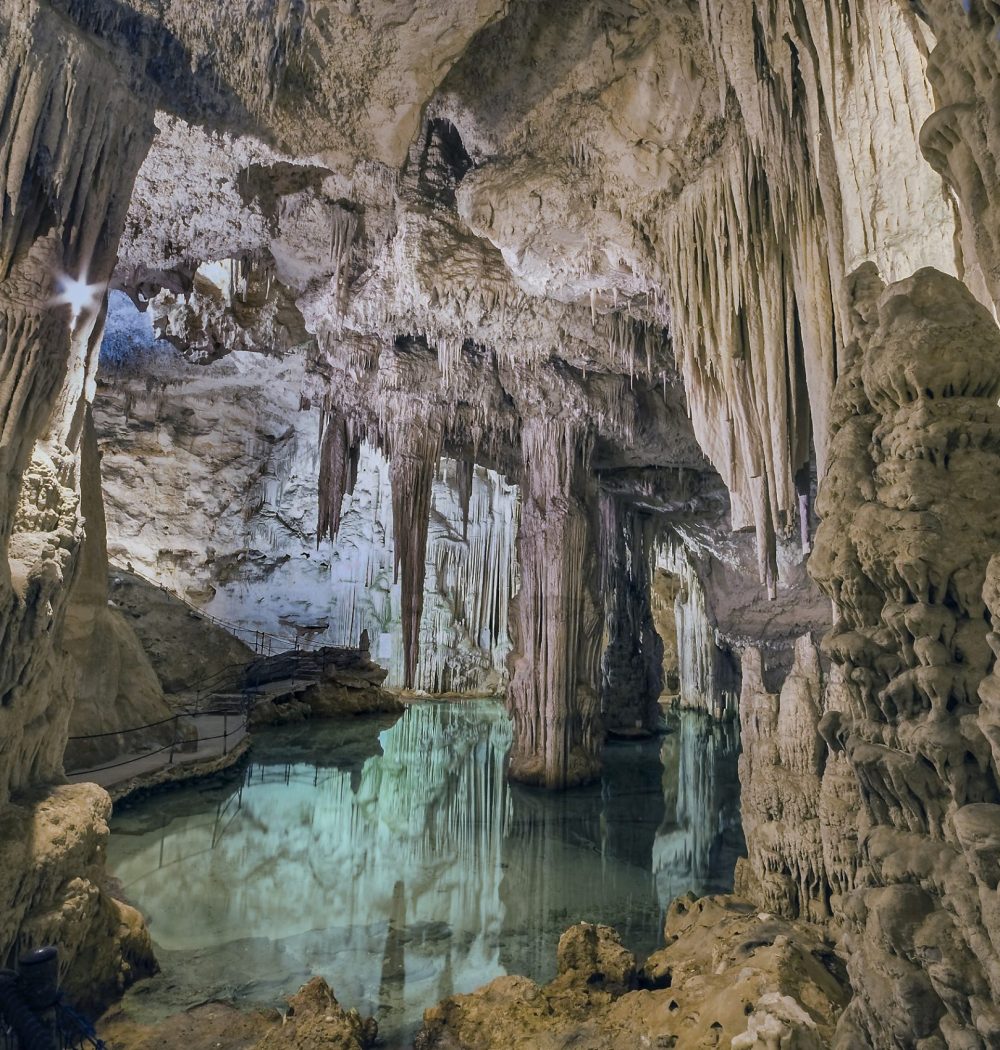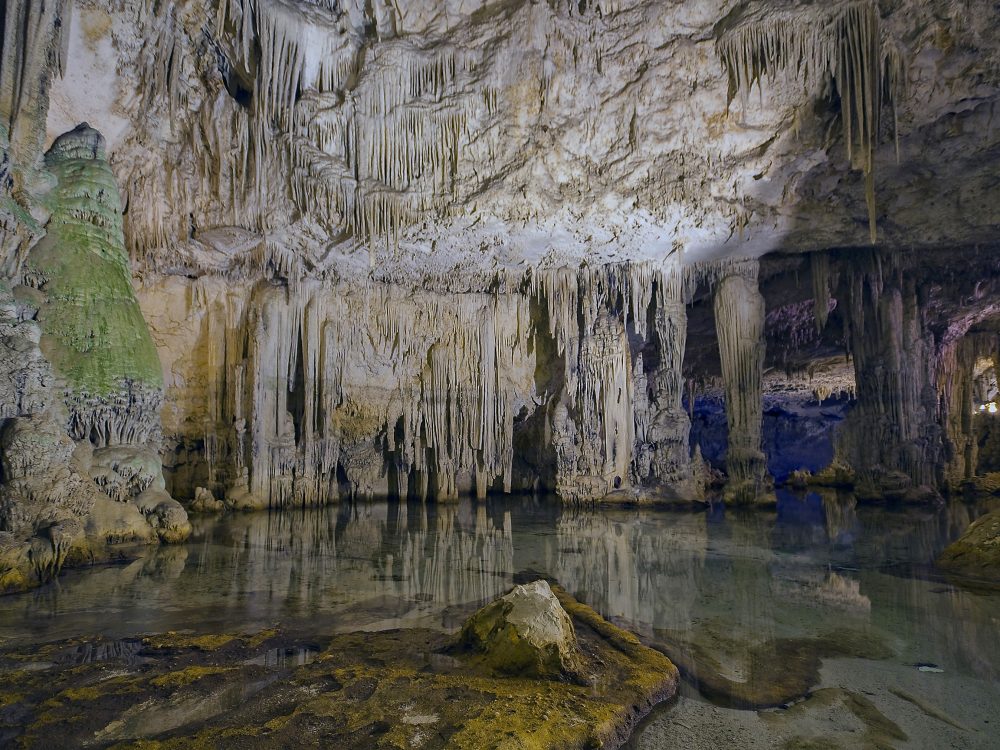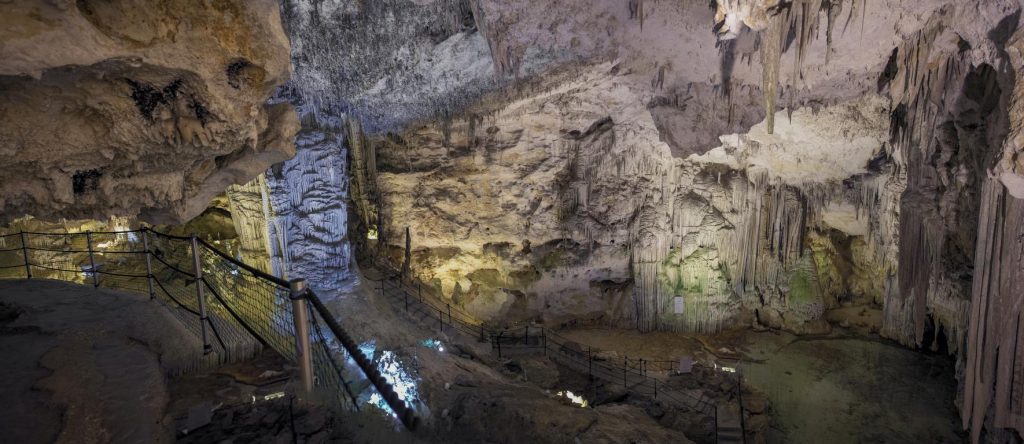“The Neptune’s Cave escapes both the word and the pen, both the chisel and the paintbrush. Everything rests on the impression, there are neither signs nor sounds able to communicate all its beauties to those which have never visited it.
And it is due to this powerlessness all the prestige of such a wonder, granted by Nature, to the lucky town Alghero.”
(E. Costa – “To the Neptune’s Cave ”, 1889)
Among the cliffs hanging over the sea of the promontory of Capo Caccia, there is one of the most charming jewels of Mediterranean nature, a place to visit at least once in life for admiring in reality its beauty and enchantment.
That's the Neptune’s Cave that, every year, attracts more than 150,000 visitors of various nationalities: 2.5 km in which alternate halls, galleries, tunnels, majestic concretions of stalagmites and stalactites, surrounded by the limpid waters of a lake.
The tourist itinerary extends for about a few hundred metres thanks to a path, obtained along the lateral ridge of the cave, that accompanies the visitor to the upper areas of the various halls.


From the entrance, in front of which the passenger boats dock, the visitors arrive at the big hall that hosts the Lake La Marmora (named after the naturalist and cartographer of the 19th century): a salt lake of transparent waters, which is considered, for its measures, one of the biggest in Europe.
In this first stretch of the cave, the walls, partially illuminated from the outside, appears glossy, with marmoreal reflections of a singular green-blue; here and there from the irregular vault hang rare stalactites in the form of an inverted cone or if they were folded up flags in different ways.
It is here that rises an imposing stalagmitic concretion, about 2 metres high, named Acquasantiera - Holy Water Font.
Hit by water dripping, eternal as the cave, this stalagmite presents on its top some small natural pools in which it collects a little quantity of freshwater as a precious source of drinking for the various species of birds that nest in the protected marine area.
After a short descent, visitors arrive at the SALA DELLE ROVINE - HALL OF RUINS, so named because of the damages caused by the visitors during the 19th century, it is adorned by big stalactites.
The next stop is in the so called SALA DELLA REGGIA – THE ROYAL PALACE HALL “the true Roundabout in the Palace of Nature”(quote).
It is here that people become fascinated, enchanted by a spectacle that is made even more majestic by the limpid waters of the lake. Such waters reflect, as in a mirror, colossal calcitic columns which rise nine metres up to height of the ceiling, almost as if they were supporting its weight.
Inlays, mosaics, fretworks, luxury in a harmonious and symmetric whole, by proportions which seem to be performed with the most accurate rules of architecture.




Right after the ceiling rises to 18 metres of height: the highest point of the tourist part.
On the lake bed, among big flows and calcitic streamers, stands out the characteristic stalagmitic formation called Albero di Natale – The Christmas Tree.
The Lake La Marmora ends with a small sandy beach, named SPIAGGIA DEI CIOTTOLINI - THE PEBBLES BEACH, because in ancient times it was formed by tiny stones, disappeared today, perhaps because of the sea erosion.
This is a small beach where, in the past, after crossing the lake, the visitors’ little boats docked, under the flickering lights of the candles placed by the sailors to illuminate the cave.
After the Reggia we meet the SMITH HALL, named after the English captain, who was among the first visitors of the cave in the 1800s.
In the centre of this hall stands the Grande Organo, the biggest, enormous and imposing column of the cave, with its flows looking like organ pipes.
The mind loses itself when attempting to make calculations to determine how many years it took that continuous, insistent, eternal drop to form this natural temple named the Neptune’s Cave!


Further along the path, we reach La Cupola-The Dome, stalagmitic formation with perfectly smooth walls, joined to the ceiling by an overlying column that stimulates the visitor’s imagination by reminding the dome of a cathedral.
After having admired the majesty of what is immensely great, the ceiling becomes lower to admire the wonders of what is immensely small: the accessories rich of fineness.
Small concretions adorning the environment of the SALA DELLE TRINE E MERLETTI - HALL OF TRINES AND LACES.
An inexhaustible mine of small works of all kinds: laces, trines, the most delicate jewellery inlays, carving, relief, watermark: the infinite world of nature!
The tour ends with the (so-called) TRIBUNA DELLA MUSICA- TRIBUNE OF THE MUSIC, a balcony that offers a panoramic view from above. Here a small orchestra played on important occasions, while the visitors danced on the underlying small beach.
